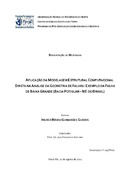Use este identificador para citar ou linkar para este item:
https://repositorio.ufrn.br/handle/123456789/18825| Título: | Aplicação da modelagem estrutural computacional direta na análise da geometria de falhas: exemplo da falha de Baixa Grande (Bacia Potiguar - NE do Brasil) |
| Autor(es): | Guedes, Ingred Maria Guimarães |
| Orientador: | Antunes, Alex Francisco |
| Palavras-chave: | Falha de Baixa Grande. Interpretação sísmica. Modelagem estrutural |
| Data do documento: | 10-Ago-2012 |
| Editor: | Universidade Federal do Rio Grande do Norte |
| Referência: | GUEDES, Ingred Maria Guimarães. Aplicação da modelagem estrutural computacional direta na análise da geometria de falhas: exemplo da falha de Baixa Grande (Bacia Potiguar - NE do Brasil). 2012. 82 f. Dissertação (Mestrado em Geodinâmica; Geofísica) - Universidade Federal do Rio Grande do Norte, Natal, 2012. |
| Resumo: | A Falha de Baixa Grande localiza-se no extremo S-SW do Rifte Potiguar, limitando, ao sul, o Graben de Umbuzeiro e parte do Graben de Apodi. Devido a grande complexidade geométrica desta falha, vários estudos foram realizados, porém ainda ocorre uma carência de análises geométricas aplicando ferramentas mais modernas, como modelagens estruturais diretas. Este trabalho propõe uma análise geométrica da Falha de Baixa Grande por meio de interpretação sísmica realizada no levantamento sísmico 3D Falha de Baixa Grande utilizando o software OpendTect (dGB Earth Sciences) e posterior aplicação de modelagens estruturais diretas: modelagem analógica direta denominada vetores de dobramentos e modelagem computacional direta 2D e 3D. A modelagem de vetores de dobramentos apresentou grande semelhança com a interpretação sísmica estrutural convencional da Falha de Baixa Grande; ou seja, a interpretação convencional foi validada geometricamente. A modelagem computacional direta 2D realizada em algumas seções do levantamento 3D de Falha de Baixa Grande foi executada no software Move (Midland Valley Ltd) pela ferramenta modelagem de horizontes por meio de um falha principal. A mesma corroborou para comprovar a influência da geometria de falha na deformação das camadas do teto da falha. A região da falha de Baixa Grande na qual a geometria é definida como rampa-patamar-rampa, gera sinformes na região côncava da falha enquanto que a região convexa gera antiformes; já na região onde ocorre predominância de falha com geometria retilínea, as camadas são deslocadas sem deformação, enquanto que as falhas com geometria curvilíneas apresentam ocorrência de rollover. Na modelagem computacional direta 3D atributos estruturais foram extraídos em horizontes no teto da falha principal após simular níveis de deformação ao longo da falha. O surgimento de estruturas indicativas de encurtamento nesta modelagem também indicou que os antiformes existentes na falha de Baixa Grande sofreram influência da geometria dos segmentos de falha |
| Abstract: | The Baixa grande fault is located on the edge of the S-SW Potiguar Rift. It limits the south part of Umbuzeiro Graben and the Apodi Graben. Although a number of studies have associated the complex deformation styles in the hanging wall of the Baixa Grande Fault with geometry and displacement variations, none have applied the modern computational techniques such as geometrical and kinematic validations to address this problem. This work proposes a geometric analysis of the Baixa Fault using seismic interpretation. The interpretation was made on 3D seismic data of the Baixa Grande fault using the software OpendTect (dGB Earth Sciences). It was also used direct structural modeling, such as Analog Direct Modeling know as Folding Vectors and, 2D and 3D Direct Computational Modeling. The Folding Vectors Modeling presented great similarity with the conventional structural seismic interpretations of the Baixa Grande Fault, thus, the conventional interpretation was validated geometrically. The 2D direct computational modeling was made on some sections of the 3D data of the Baixa Grande Fault on software Move (Midland Valley Ltd) using the horizon modeling tool. The modeling confirms the influence of fault geometry on the hanging wall. The Baixa Grande Fault ramp-flat-ramp geometry generates synform on the concave segments of the fault and antiform in the convex segments. On the fault region that does not have segments angle change, the beds are dislocated without deformation, and on the listric faults occur rollover. On the direct 3D computational modeling, structural attributes were obtained as horizons on the hanging wall of the main fault, after the simulation of several levels of deformation along the fault. The occurrence of structures that indicates shortening in this modeling, also indicates that the antiforms on the Baixa Grande Fault were influenced by fault geometry |
| URI: | https://repositorio.ufrn.br/jspui/handle/123456789/18825 |
| Aparece nas coleções: | PPGG - Mestrado em Geodinâmica e Geofísica |
Arquivos associados a este item:
| Arquivo | Descrição | Tamanho | Formato | |
|---|---|---|---|---|
| IngredMGG_DISSERT.pdf | 2,76 MB | Adobe PDF |  Visualizar/Abrir |
Os itens no repositório estão protegidos por copyright, com todos os direitos reservados, salvo quando é indicado o contrário.

